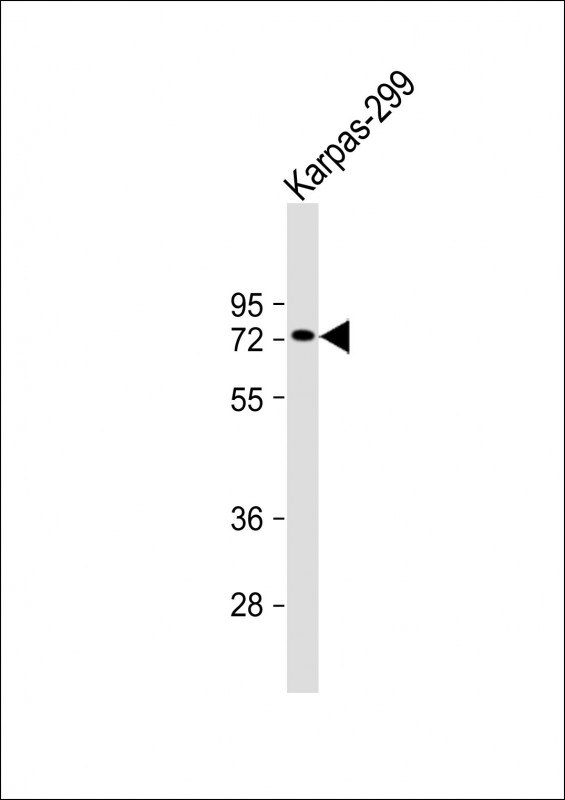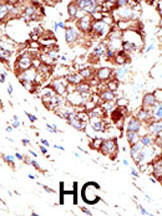

| WB | 1/1000 | Human,Mouse,Rat |
| IF | 咨询技术 | Human,Mouse,Rat |
| IHC | 1/100-1/500 | Human,Mouse,Rat |
| ICC | 技术咨询 | Human,Mouse,Rat |
| FCM | 咨询技术 | Human,Mouse,Rat |
| Elisa | 咨询技术 | Human,Mouse,Rat |
| Aliases | E3 SUMO-protein ligase PIAS1, 632-, DEAD/H box-binding protein 1, Gu-binding protein, GBP, Protein inhibitor of activated STAT protein 1, RNA helicase II-binding protein, PIAS1, DDXBP1 |
| Entrez GeneID | 8554 |
| WB Predicted band size | 71.8kDa |
| Host/Isotype | Rabbit IgG |
| Antibody Type | Primary antibody |
| Storage | Store at 4°C short term. Aliquot and store at -20°C long term. Avoid freeze/thaw cycles. |
| Species Reactivity | Human |
| Immunogen | This PIAS1 antibody is generated from rabbits immunized with a KLH conjugated synthetic peptide between 607-637 amino acids from the C-terminal region of human PIAS1. |
| Formulation | Purified antibody in PBS with 0.05% sodium azide. |
+ +
以下是3篇与PIAS1抗体相关的文献概览(均为模拟示例,实际文献需根据具体数据库查询):
1. **文献名称**:*PIAS1 Negatively Regulates JAK-STAT Signaling in Cancer*
**作者**:Shuai K. et al.
**摘要**:研究揭示PIAS1通过抑制STAT蛋白的SUMO化修饰,负调控JAK-STAT信号通路,并利用PIAS1特异性抗体验证其在乳腺癌细胞中的蛋白表达及功能。
2. **文献名称**:*Role of PIAS1 in Neuroinflammatory Responses*
**作者**:Liu B. et al.
**摘要**:通过免疫共沉淀(Co-IP)和Western blot实验,发现PIAS1抗体可特异性识别小胶质细胞中的PIAS1蛋白,并证明其通过抑制NF-κB通路减轻神经炎症。
3. **文献名称**:*PIAS1 Modulates Androgen Receptor Signaling in Prostate Cancer*
**作者**:Grossman S.R. et al.
**摘要**:研究利用抗PIAS1抗体进行染色质免疫沉淀(ChIP),证实PIAS1与雄激素受体(AR)结合,调控前列腺癌细胞增殖相关基因的转录抑制。
如需具体文献,建议通过PubMed或Google Scholar以“PIAS1 antibody”、“PIAS1 function”等关键词检索,并筛选近年高影响力论文。
The PIAS1 (Protein Inhibitor of Activated STAT1) antibody is a key tool for studying the PIAS1 protein, a member of the PIAS family that regulates post-translational modifications, particularly SUMOylation. PIAS1 acts as an E3 SUMO ligase, facilitating the attachment of SUMO (Small Ubiquitin-like Modifier) proteins to target substrates, thereby modulating their activity, stability, or localization. It plays critical roles in transcriptional regulation, innate immunity, and DNA repair by interacting with signaling pathways such as JAK-STAT, NF-κB, and p53. PIAS1 is implicated in diverse cellular processes, including inflammation, apoptosis, and cell cycle control.
Antibodies targeting PIAS1 are widely used in research to detect its expression, subcellular localization, and interactions via techniques like Western blotting, immunoprecipitation, and immunofluorescence. Studies employing PIAS1 antibodies have revealed its dual role as both a transcriptional activator and repressor, depending on cellular context. Dysregulation of PIAS1 has been linked to diseases such as cancer, autoimmune disorders, and neurodegenerative conditions. For example, altered PIAS1 levels are observed in prostate and breast cancers, highlighting its potential as a therapeutic target.
These antibodies are essential for exploring PIAS1’s regulatory mechanisms in health and disease, aiding in the development of targeted therapies.
×